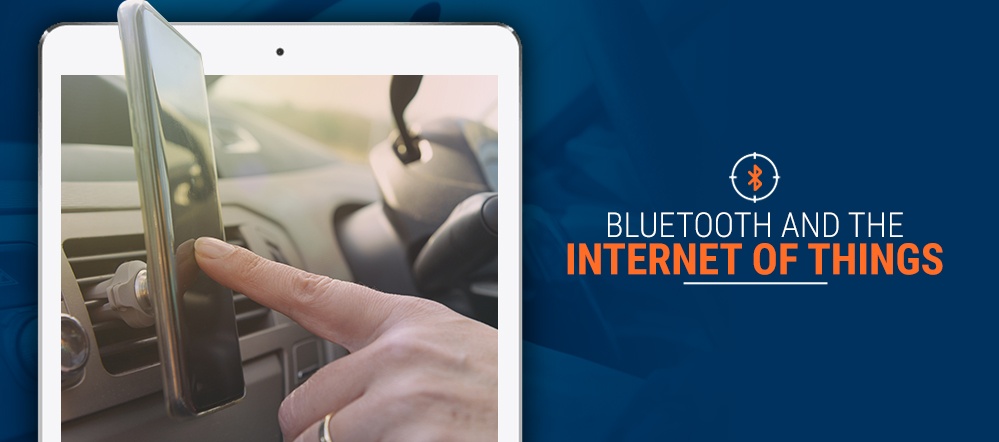

Computers and smartphones are no longer the only items that can connect to the internet. As wireless networks became more prevalent and the cost of computer chips continued to shrink, the variety and number of interconnected devices increased. All of those interconnected devices are known as the Internet of Things (IoT). IoT includes things such as WiFi-enabled refrigerators, wearable fitness trackers and fleet tracking devices.
Although some IoT devices get online using a WiFi connection, many devices rely on Bluetooth to connect. Bluetooth was developed in the mid-1990s, and the first specification was released in 1999. Since then, new specifications have been released periodically, with the most recent update being Bluetooth 5. Bluetooth 5 is a further update on Bluetooth Low Energy (BLE), sometimes called Bluetooth 4 or Bluetooth Smart. Compared to “classic” Bluetooth, BLE uses considerably less power. Devices that connect using BLE also tend to send considerably smaller amounts of data compared to devices that connect over classic Bluetooth.
Over the past few decades, the number of internet-connected devices has increased exponentially. In the 1990s, there were around 1 billion devices that could get online. By the early 2000s, the number had doubled to 2 billion. By 2021, it’s estimated that 48 billion devices will connect to the internet. By 2024, 31% of those devices are expected to use Bluetooth technology to connect, a jump from 13% in 2018.
The odds are likely that you have used or seen an IoT device in your daily life that uses Bluetooth technology. Some common examples of IoT Bluetooth-connected devices include:

BLE allows two devices to “talk” to each other over radio waves. The radio spectrum ranges from 1 hertz (Hz) to 3,000 gigahertz (GHz). The spectrum is split up into frequency bands and each band is assigned a specific application, such as FM or AM radio. Frequencies below 9 KHz are unallocated, meaning you don’t need a license to use them. Bluetooth is on the 2.4 GHz spectrum band, which is the same spectrum used by cordless phones, microwaves and WiFi.
When more than one device on the same spectrum band is used simultaneously, there is the chance for interference, which is why you might notice some crackling in a Bluetooth speaker if you try to load a webpage while using it or why you might hear some static on a cordless phone when you use it near a microwave. To minimize interference, devices will hop frequencies in an attempt to find an available one.
The technology works by pairing Bluetooth gateways or Bluetooth-enabled devices, such as a laptop or smartphone, with other Bluetooth-enabled devices, such as an asset tracker tag, a fitness tracker or a car stereo. One of the devices, such as the gateway or smartphone, acts as the master device. The connected devices are known as “slaves,” as they have to do the bidding of the master device.
The master device determines which frequencies on the 2.4 GHz band to use to establish a reliable connection between it and the peripheral devices. Depending on how busy the frequency band is, the device might hop from frequency to frequency to minimize interference and ensure a smooth connection. The most recent form of Bluetooth, Bluetooth 5, uses something called Slot Availability Masks to minimize interference and allow it to make the best use of the radio spectrum. It also has improved frequency hopping, which allows it to work well even in busy areas.
Bluetooth and IoT technology can help with fleet monitoring. BLE and IoT management solutions allow fleet managers to remain in compliance with Federal Motor Carrier Safety Administration (FMCSA) rules without requiring them to invest in expensive equipment. Thanks to BLE, many fleet managers can use a bring-your-own-device (BYOD) electronic logging device (ELD). A BYOD ELD features a small enclosure that connects to the vehicle’s engine. The enclosure contains a GPS receiver and a CAN transceiver that records the time spent behind the wheel. The information can then be sent to the driver’s smartphone or another connected device over BLE.
BYOD ELD systems have a few advantages over hardwired systems. They tend to have a lower upfront price, as they don’t include an additional tablet or device. They depend on the driver having a Bluetooth-enabled smartphone or tablet. They also offer more flexibility compared to hardwired systems, as they can be easily unplugged from one vehicle and plugged into another if needed. BYOD ELD systems also often offer over-the-air firmware updates, making it easy to keep the system update and functional.
Fleet managers can also use Bluetooth low energy tech for asset tracking. You can install Bluetooth tags or wireless sensors on equipment and tools to help reduce the risk of theft or to help increase the likelihood of recovering stolen items.
Track Your Truck’s Pacific Track PT30 ELD is a BYOD ELD device that is FMCSA Certified. The ELD can be a cost-effective way to remain in compliance with Hours of Service rules and to protect your drivers. To learn more about how you can use Bluetooth-enabled devices and the IoT to keep your drivers safe and to protect your fleet and assets, contact us to request a quote today.